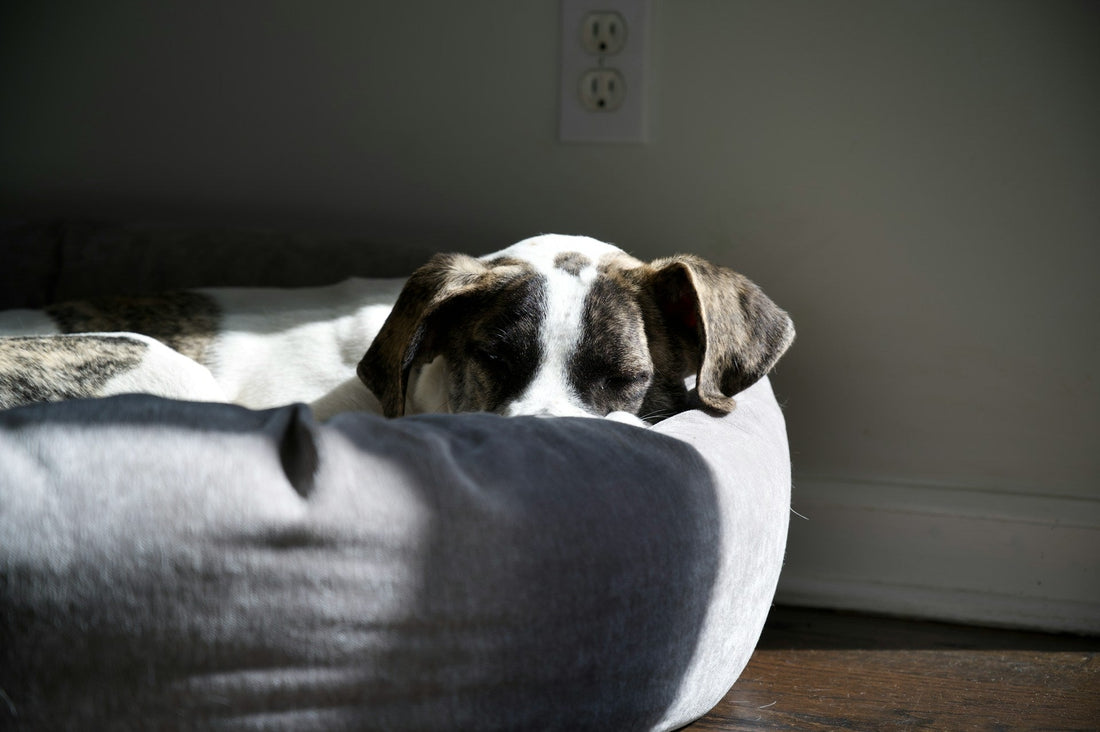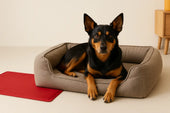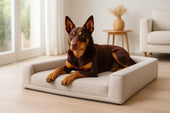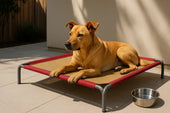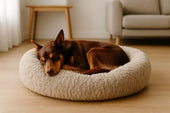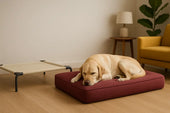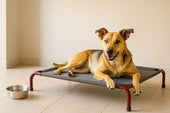Key Takeaways
- Dog beds can be a hidden source of allergies for both dogs and humans, harbouring dust mites, mould, dander, and chemical residues.
- Allergy symptoms may appear as itching, sneezing, coughing, skin rashes, or breathing issues in pets and people.
- Certain bedding materials and poor cleaning routines increase allergy risk, especially in Australia’s variable climate.
- Regular cleaning and choosing hypoallergenic dog beds can greatly reduce allergen build-up in your home.
- Australian pet owners can minimise allergies by following expert cleaning advice, selecting safe bedding materials, and consulting local vets if symptoms persist.
Introduction
A good night’s sleep is vital for your dog’s health and happiness, but have you ever considered whether your pet’s bed might be doing more harm than good? For many Australian pet owners, dog beds are an afterthought—simply a soft spot for their furry friend to rest. Yet, beneath those cosy layers can lurk allergens that may affect not just your dog, but also your family.
Allergic reactions linked to pet bedding are on the rise, especially as more households welcome pets indoors and prioritise their comfort. Whether it’s your dog constantly scratching or a family member sneezing when near the dog bed, these seemingly minor issues might actually point to a larger problem: your dog’s bed could be the source of persistent allergies.
In this article, we’ll explore how dog beds can cause allergies, identify the main triggers, and provide practical solutions to keep your home and pets healthy. With Australian data, quotes from local experts, and step-by-step advice, you’ll learn how to transform your dog’s bed from an allergy hotspot into a safe, comfy haven.
Understanding Allergies: A Simple Explanation
Allergies are exaggerated immune responses to substances that are usually harmless—like dust, pollen, or pet dander. In both dogs and humans, allergies can manifest in various ways, from mild sneezing and itching to more severe symptoms like skin rashes or asthma attacks.
Common signs of allergies in dogs include:
- Itchy or red skin
- Excessive scratching or licking
- Ear infections
- Watery eyes or runny nose
- Hair loss or hot spots
For humans, allergy symptoms often appear as:
- Sneezing and runny nose
- Itchy, watery eyes
- Skin rashes or hives
- Wheezing or difficulty breathing
Allergens don’t just float in the air—they settle on surfaces, especially soft furnishings like dog beds. As your dog sleeps, rolls, and scratches, these allergens get stirred up and can easily be inhaled or come into contact with skin.
Dr. Katherine Dale, an Australian veterinary dermatologist, explains:
“Dog beds are a common but overlooked source of allergen exposure. Both pets and people can suffer, especially in homes where cleaning routines aren’t robust or bedding materials aren’t chosen carefully.”
In short, if your dog or your family is experiencing ongoing allergy symptoms, it’s worth taking a closer look at the bed your dog spends hours on each day.
How Dog Beds Can Trigger Allergies
Dog beds seem like harmless comfort zones, but they are often a significant source of allergens in the home. These allergens can affect not just your dog, but you and your family as well. Understanding exactly how and why this happens is the first step to solving the problem.
Materials Used in Dog Beds and Common Allergens
The materials used to construct dog beds can be a major contributor to allergy issues. Many beds are filled with synthetic foams, polyester fibres, or treated cotton, all of which can harbour dust mites and trap pet dander. Some imported beds may even be treated with chemical flame retardants or anti-fungal agents that can trigger sensitivities in both humans and pets.
Common materials that may cause problems include:
- Polyester fibre filling: Attracts and traps dust mites.
- Memory foam: Can retain moisture, creating an environment for mould.
- Treated cotton or fabrics: Chemical treatments may irritate sensitive skin.
The Role of Dust Mites, Mould, and Pet Dander
- Dust mites are microscopic creatures that feed on dead skin cells shed by both dogs and humans. They thrive in warm, humid environments—like your dog’s bed. Their droppings are highly allergenic and are a leading cause of indoor allergies (Australian Society of Clinical Immunology and Allergy).
- Mould and mildew can develop in dog beds that become damp from dog saliva, urine, or a humid environment, particularly in parts of Australia prone to high humidity or wet weather. Mould spores are a potent trigger for allergic reactions.
- Pet dander (tiny flakes of skin and hair) builds up quickly in soft bedding. It is a primary cause of allergies in people, and even dogs can become sensitive to the buildup of their own or other animals’ dander.
Chemical Treatments and Manufacturing Residues
Dog beds, especially lower-priced or imported products, may contain chemical residues from manufacturing, such as formaldehyde, dyes, flame retardants, or anti-microbial agents. Over time, these chemicals can off-gas or leach out, contributing to allergic responses. This is particularly concerning for young children or pets with sensitive skin.
Dr. Alex Hynes, veterinarian and host of Bondi Vet, notes:
“Chemical sensitivity is a growing problem, especially for dogs with pre-existing allergies. Choosing bedding with minimal or no chemical treatments is an important step in preventing unnecessary reactions.”
Case Study: Real Examples from Australian Homes
A family in Brisbane noticed their Labrador developing recurring skin rashes and constant itching. After ruling out food allergies and fleas, their vet suggested switching to a hypoallergenic dog bed made of natural, untreated cotton. Within a few weeks, the dog’s symptoms dramatically improved. Similarly, a Sydney-based pet owner struggled with her child’s constant sneezing and discovered, through allergy testing, that dust mites in the dog’s bed were a significant culprit.
Identifying the Signs: Is Your Dog’s Bed the Culprit?
Pinpointing the source of allergies can be challenging, especially when symptoms overlap with other common issues. However, if you notice persistent health concerns in your household—either in your dog or in family members—it’s wise to consider the dog’s bed as a possible trigger.
Symptoms of Allergies in Dogs
If your dog is suffering from allergies caused by its bed, you might observe:
- Frequent scratching, licking, or biting at the skin
- Red or inflamed skin, especially on the belly, paws, or face
- Chronic ear infections
- Hair loss or “hot spots”
- Watery eyes, sneezing, or nasal discharge
- Restless or disrupted sleep patterns
According to Greencross Vets, these symptoms can often worsen at night or after your dog spends time resting on its bed. If you notice that your dog seems better after spending time away from its bedding—or symptoms return after lying on the bed—this could be a key clue.
Symptoms of Allergies in Humans
Humans can also react to allergens that accumulate in dog beds, particularly if the bed is in a shared space such as the living room or bedroom. Watch for:
- Sneezing, runny or stuffy nose
- Itchy, watery, or red eyes
- Coughing, wheezing, or difficulty breathing
- Skin irritation, hives, or eczema flare-ups
- Worsening of asthma symptoms (especially in children)
If symptoms improve after cleaning or replacing the dog bed, this is a strong indicator that the bed was contributing to the issue.
When to Suspect the Bed: Key Patterns and Clues
Ask yourself:
- Do symptoms coincide with your dog spending time on their bed?
- Are symptoms worse after cleaning or fluffing the bed, which might stir up dust and dander?
- Does the bed have a musty smell, or can you see signs of mould, dust, or dirt build-up?
- Do symptoms improve when your dog sleeps elsewhere or when the bed is washed?
If you answer “yes” to any of these, it’s time to take a closer look at the dog’s bed.
Expert Insight
Dr. Rob Zammit, an Australian veterinarian and pet health advisor, shares:
“Many owners overlook bedding as a source of allergens, focusing instead on food or environmental factors. In reality, unwashed or low-quality dog beds are one of the most common sources of ongoing skin and respiratory issues for both pets and people.”
The Science Behind Allergens in Dog Beds
Understanding how allergens build up in dog beds helps pet owners tackle the root of the problem rather than just treating the symptoms. Beds are designed to be soft, warm, and inviting, but these same characteristics create the ideal environment for allergens to accumulate and thrive.
How Allergens Accumulate in Bedding Materials
Dog beds are exposed daily to fur, skin cells, sweat, saliva, and even the dirt your dog brings in from outside. Over time, these materials penetrate deep into the fabric and filling, creating a haven for:
- Dust mites, which feed on shed skin cells.
- Mould spores, thriving in damp or humid conditions.
- Pet dander and hair, which stick to fabrics and fibres.
- Chemical residues that may not wash out completely.
A 2022 review published by the Australian Society of Clinical Immunology and Allergy highlights that soft furnishings—like bedding and couches—are major reservoirs for household allergens. Because dog beds are often overlooked in cleaning routines, allergen levels can become higher than in human bedding.
Scientific Studies and Expert Commentary
A 2019 study in the Journal of Veterinary Dermatology found that up to 90% of dog beds tested in Australian homes contained dust mite allergens at levels known to trigger reactions in sensitive pets and people.
Link: Veterinary Dermatology Journal
PetMD’s dog bed care guide (PetMD Dog Bed Care) advises:
“Regular and thorough cleaning of pet bedding is essential for controlling allergen exposure. Failing to wash pet bedding frequently can lead to an increase in allergens, especially in households where pets have direct contact with beds and couches.”
The Impact of Australia’s Climate on Allergen Growth
Australia’s climate is unique—ranging from humid subtropical regions in Queensland and New South Wales to arid and temperate zones elsewhere. Warm, moist environments encourage dust mite populations and mould growth, making it particularly important for pet owners in these areas to clean and air out dog beds regularly.
In addition, bushfire smoke and outdoor pollens—prevalent in many Australian cities and regional areas—can also settle into dog beds, compounding the allergy risk for sensitive pets and people.
The Australian Government Department of Health recommends increased cleaning frequency during high pollen and bushfire seasons.
Why the Problem Is Getting Worse
With more Australian families treating pets as part of the household and bringing them indoors, the amount of time dogs spend on soft furnishings—including beds—has increased. This raises the risk of allergen exposure for everyone in the home.
Common Allergens Found in Dog Beds
The composition and cleanliness of your dog’s bed can directly affect how many allergens it harbours. Understanding the specific culprits is crucial for effective prevention and management, especially in Australia where climate and lifestyle can exacerbate certain issues.
Dust Mites and Microscopic Insects
Dust mites are one of the most common—and troublesome—allergens found in dog beds. They feed on dead skin cells and thrive in warm, humid environments, making the soft filling and fabric of dog beds an ideal home. Their droppings contain potent allergens that trigger reactions in both dogs and humans.
According to the Australian Society of Clinical Immunology and Allergy, dust mites are a leading cause of allergy symptoms in Australian homes, particularly along the east coast where humidity is high.
Pet Dander and Saliva
Pet dander refers to tiny flakes of skin and fur that your dog sheds regularly. Saliva, which contains proteins that can also trigger allergies, is transferred to the bed when your dog licks or chews it, or even just by drooling in their sleep. Over time, both dander and saliva accumulate, increasing the risk of allergic reactions—especially for children or adults who cuddle with pets on their beds.
Mould and Mildew
Mould and mildew thrive in damp or poorly ventilated environments. Dog beds that become wet from accidents, drool, or high humidity (common in coastal Australia) can develop invisible mould colonies inside the filling. Mould spores are known to cause significant respiratory irritation and skin allergies in both humans and pets.
A study by the National Asthma Council Australia found that frequent exposure to mould in household fabrics—including pet beds—can aggravate asthma and allergic symptoms.
Chemical Residues from Manufacturing
Some dog beds, particularly those made overseas, may be treated with chemical agents like formaldehyde, dyes, flame retardants, or anti-microbial treatments. These substances can persist long after purchase and may “off-gas,” especially in Australia’s warm climate. Sensitive pets or family members can react with skin rashes, eye irritation, or respiratory discomfort.
Pollen and Outside Contaminants
Dogs love to explore outside, often returning to their beds carrying pollen, grass, and even spores from plants. These outside allergens become embedded in bedding, particularly if it is not washed frequently. In spring and summer, when pollen counts are highest, the risk is especially significant for allergy-prone households.
Dr. Katie Grzyb, DVM, advises via PetMD:
“Allergens like pollen can easily accumulate in your pet’s bedding, and simple washing techniques may not be enough if you’re not using the right products or washing often enough.”
How Often Should You Clean Your Dog’s Bed?
Cleaning your dog’s bed is one of the simplest yet most effective ways to minimise allergen exposure for both pets and humans. However, the frequency and method of cleaning can make a significant difference, especially in Australia’s diverse climates.
Expert Recommendations and Australian Perspectives
Veterinary experts and allergists agree: dog beds should be cleaned at least once a week. In humid or high-allergen seasons (like spring), more frequent washing may be necessary. The Australian Society of Clinical Immunology and Allergy also recommends using hot water—above 55°C—to effectively kill dust mites and remove allergens from bedding materials.
Dr. Justine Lee, DVM and pet safety expert, writes on Pet Health Network:
“It’s not just about odour control. Washing your dog’s bed is crucial for controlling allergens and infectious agents, especially in multi-pet homes or when someone in the family is allergy-prone.”
Step-by-Step Cleaning Guide
- Check the Label: Always read the manufacturer’s instructions before washing. Some beds have removable, machine-washable covers, while others require spot cleaning or hand washing.
- Vacuum Thoroughly: Before washing, vacuum the bed to remove loose hair, dander, dirt, and dust mites.
- Use Hot Water: Wash the cover and inner cushion in hot water (above 55°C) to kill dust mites and remove allergens.
- Mild, Pet-Safe Detergent: Use a fragrance-free, non-toxic detergent to avoid skin irritation or chemical residues.
- Rinse Well: Double-rinse to ensure no detergent remains.
- Dry Completely: Dry the bed on high heat if possible, or under direct Australian sunlight to further kill bacteria and mites.
- Spot Clean Between Washes: Use a pet-safe spray or wipes for quick touch-ups, especially after accidents or muddy outings.
Choosing Cleaning Products Safe for Pets and People
Always opt for detergents and stain removers labelled as pet-safe, hypoallergenic, and free from harsh chemicals, fragrances, or dyes. Avoid bleach, ammonia, or products containing essential oils (like tea tree) that can be toxic to dogs.
For Australian pet owners, brands like Eco Store and Earth Choice offer gentle, environmentally friendly cleaning solutions widely available at supermarkets.
Quote or Tip from a Pet Hygiene Expert
Anna Webb, pet behaviourist and co-host of Australia’s The Pet Show:
“A clean dog bed isn’t just about comfort—regular cleaning helps control everything from fleas to allergies. Make it a weekly ritual, and your pets and family will thank you.”
Choosing the Right Dog Bed for Allergy Prevention
Selecting the right bed is a critical step in reducing allergen build-up and protecting both your dog and your family. Not all dog beds are created equal—some materials and designs are far better for allergy control, particularly in Australia’s climate.
Hypoallergenic Materials: What Actually Works?
The term “hypoallergenic” is often used in marketing, but not all products live up to their promises. When shopping for an allergy-friendly dog bed, look for:
- Tightly-woven cotton or microfibre: These materials prevent dust mites and dander from settling deep into the fabric.
- Natural latex or untreated wool: Naturally resistant to dust mites and mould, provided they’re processed without added chemicals.
- Synthetic memory foam (with a removable, washable cover): Memory foam itself is less hospitable to dust mites if kept dry, but it must be protected from spills and moisture.
- Bamboo and hemp blends: Increasingly popular in Australia for their breathability and natural resistance to mould and bacteria.
Avoid beds with thick, loose stuffing, heavy quilting, or plush surfaces that trap moisture and allergens.
Types of Beds Least Likely to Trigger Allergies
- Elevated (cot-style) beds: These keep your dog off the ground, allow for better air circulation, and reduce dust and dander accumulation.
- Beds with removable, machine-washable covers: Essential for regular deep cleaning.
- Minimalist designs: Fewer nooks and crannies for allergens to hide.
Australian company Snooza is known for producing beds with removable, washable covers and hypoallergenic fillings, popular among local pet owners concerned about allergies.
Certifications and Labels to Look for in Australia
- Oeko-Tex Standard 100: Certifies that fabrics are free from harmful substances.
- Australian Made Certification: Indicates local manufacturing, which often means better regulation of chemical use.
- Hypoallergenic claims: Check for specific details about materials and testing rather than relying on vague marketing terms.
Avoiding Beds with Heavy Chemical Treatments
Many imported or low-cost beds are treated with chemicals for stain resistance or fire retardancy. While this may offer durability, these substances can off-gas or cause skin irritation and should be avoided in allergy-prone homes.
Dr. Sarah Howard, veterinary dermatologist with the Australian Veterinary Association, advises:
“When choosing a bed for a sensitive dog, less is often more. Choose natural or certified-safe materials, and wash new bedding before use to remove any manufacturing residues.”
Practical Steps for Reducing Allergens in Your Home
Prevention is always better than cure—especially when it comes to managing allergies triggered by your dog’s bed. Alongside choosing the right bedding and cleaning it regularly, simple changes to your home environment and daily routines can make a major difference.
Regular Cleaning Routines for Dog Beds and Surrounding Areas
- Vacuum and mop floors weekly around your dog’s sleeping area, focusing on corners, skirting boards, and under furniture where dust and dander accumulate.
- Launder your dog’s bedding at least once a week in hot water with a mild, pet-safe detergent.
- Wash toys, blankets, and nearby soft furnishings that your dog frequently uses.
- Rotate between two or more beds or covers so you always have a clean option ready.
Air Quality Improvement Tips
- Ventilation: Open windows regularly to allow fresh air to circulate, reducing indoor allergen build-up.
- Use air purifiers: Choose models with HEPA filters, which trap airborne allergens like dander, dust mites, and pollen.
- Dehumidifiers: In humid parts of Australia, use dehumidifiers to keep indoor humidity below 50%, discouraging dust mite and mould growth.
- Avoid heavy curtains and thick carpets in pet areas, as these trap allergens.
According to the National Asthma Council Australia, maintaining dry and well-ventilated spaces is essential for controlling indoor allergies, especially during Australia’s humid seasons.
Grooming and Bathing Your Dog to Reduce Dander
- Brush your dog regularly (outdoors if possible) to remove loose fur and skin flakes.
- Bathe your dog every 4–6 weeks using a gentle, hypoallergenic shampoo, unless otherwise directed by your vet.
- Wipe your dog’s paws and coat after outdoor walks to minimise tracking pollen and dirt indoors.
How to Spot and Fix Hidden Moisture or Mould Problems
- Check for dampness under and inside dog beds, especially if they’re placed on carpets or in poorly ventilated rooms.
- Look for musty smells, discoloration, or visible mould on bedding, walls, or floors.
- Move beds away from external walls or windows prone to condensation.
- Promptly address plumbing leaks or spills and ensure bedding dries fully before reuse.
Extra Tips for Allergy-Prone Households
- Consider allergy covers for dog beds—these zippered barriers block dust mites and dander.
- Limit your dog’s access to bedrooms, especially if someone in the household has asthma or severe allergies.
- Regularly clean air-conditioning and heating vents to prevent dust and allergen circulation.
Dr. Ryan Ong, allergy specialist at Perth Children’s Hospital, recommends:
“Small, consistent changes—like weekly washing and good ventilation—often have a bigger impact on allergy symptoms than any single product or treatment.”
When to Seek Professional Help
Despite your best cleaning efforts and careful product choices, allergies can sometimes persist or even worsen. Knowing when to seek professional help is crucial for the health and wellbeing of both your dog and your family.
When Allergies Persist Despite Your Best Efforts
If your dog or family members continue to experience allergy symptoms after you have:
- Regularly cleaned and replaced bedding
- Improved home ventilation and air quality
- Switched to hypoallergenic products and materials
- Eliminated other common sources of allergens (like carpets or curtains near the dog bed)
…it’s time to consult a professional. Persistent allergies may indicate an underlying health condition, a more severe allergy, or the presence of hidden mould or contaminants in your home.
Consulting with Veterinarians, Allergists, or Cleaning Specialists
For your dog:
If you notice signs such as chronic scratching, skin lesions, hair loss, ear infections, or unusual behaviour, consult your veterinarian. They can perform allergy testing, recommend medicated shampoos, or suggest dietary changes to help manage symptoms. Some Australian vets specialise in dermatology or allergies and can offer advanced solutions.
For people in your household:
If family members experience ongoing symptoms such as sneezing, itchy eyes, or asthma attacks—particularly if these improve away from home or worsen near the dog bed—consult a GP or an allergy specialist. Doctors can arrange allergy testing to pinpoint triggers and may recommend medical treatments or environmental controls.
Professional cleaning:
If mould is suspected or visible in bedding or home furnishings, consider hiring a professional cleaning or remediation service. Australian services like Jims Cleaning and Allergy Free offer specialist cleaning for allergy-prone homes.
Australian Health and Veterinary Resources
- Healthdirect Australia — Trusted health information and resources, including allergy management tips.
- RSPCA Australia — Advice on pet care and welfare, with links to local vet services.
- Australian Society of Clinical Immunology and Allergy — Guidance and support for managing allergies in the home.
Quote from a Veterinary Expert
Dr. Sharon Bryden, Australian veterinary dermatologist, comments:
“If home management doesn’t control allergy symptoms, professional advice can make all the difference. Persistent skin or respiratory issues should never be ignored, as they can signal more serious health concerns for both pets and people.”
Frequently Asked Questions (FAQs)
Can my dog develop allergies from its own bed?
Yes, dogs can develop allergies or sensitivities to dust mites, mould, and chemical residues that accumulate in their beds. This often shows as itchy skin, excessive licking, or chronic ear infections. If symptoms appear soon after your dog lies on its bed, the bedding may be the culprit. Regular cleaning and hypoallergenic materials can help minimise these risks.
What materials should I avoid if my dog or I have allergies?
Avoid beds filled with loose, synthetic stuffing, thick plush fabrics, or those treated with strong chemicals (such as stain-resistant coatings or flame retardants). Instead, look for tightly-woven cotton, untreated natural fibres, and beds labelled “hypoallergenic” or “chemical-free.” Always check for Australian certifications and read manufacturer details.
How can I tell if my dog’s bed is causing health problems?
Key signs include your dog scratching, licking, or developing rashes after resting on its bed, or family members sneezing, coughing, or having skin reactions in areas where the bed is located. If symptoms improve after cleaning or replacing the bed, it’s a strong indicator that allergens from the bed were to blame.
Is washing enough, or should I replace the bed?
Washing is essential, but beds that are old, difficult to clean, or have developed musty smells or visible mould should be replaced. For persistent allergy issues, invest in a new bed made of hypoallergenic materials with removable, washable covers. Remember to wash all bedding and covers weekly.
Are “anti-allergy” beds actually effective?
Some “anti-allergy” beds are genuinely helpful, especially those made with tightly woven covers, natural latex, or certified hypoallergenic materials. However, no bed is completely allergen-proof. The key is to combine a suitable bed with frequent cleaning and good home hygiene. Always check for reputable certifications and genuine product reviews from Australian pet owners.
What’s the best way to clean my dog’s bed if someone in the house has severe allergies?
Use hot water (above 55°C), a hypoallergenic or fragrance-free detergent, and dry the bedding thoroughly in a dryer or direct sunlight. Consider using allergy covers for the bed and run an air purifier in rooms where the bed is kept. Wash your hands and avoid shaking out bedding indoors, as this can spread allergens.
Should I let my dog sleep in the bedroom if someone has allergies?
It depends on the severity of the allergies. For mild allergies, keeping the bed clean and using an air purifier may be enough. For severe allergies or asthma, it’s best to keep your dog’s bed out of the bedroom and wash all bedding and soft furnishings frequently.
Where can I get more help or advice?
- Australian Society of Clinical Immunology and Allergy
- Healthdirect Australia
- Your local veterinarian or pet dermatologist for animal-specific concerns.
Conclusion
Dog beds are a staple in every Australian pet owner’s home, but they can also be a hidden source of allergies affecting both your pet and your family. By understanding how allergens accumulate in bedding—from dust mites and mould to chemical residues and outdoor contaminants—you can take concrete steps to protect everyone’s health.
Regular, thorough cleaning is essential. Washing your dog’s bed weekly with hot water and a hypoallergenic detergent, vacuuming pet areas, and drying bedding completely can dramatically reduce allergen build-up. When choosing a new bed, opt for hypoallergenic materials, avoid heavy chemical treatments, and select designs that are easy to clean.
If you notice allergy symptoms that don’t resolve with improved hygiene, don’t hesitate to consult your vet or an allergy specialist. Persistent scratching, skin rashes, or respiratory symptoms are never normal and should be investigated to ensure lasting health for everyone in your household.
Ultimately, providing a clean, safe sleeping space is one of the most loving things you can do for your dog—and for your family. With a little attention and routine care, you can transform your dog’s bed from an allergy hotspot to a haven of comfort and wellbeing.
For more expert tips on pet care, bedding choices, and managing allergies, visit reputable sources like the Australian Society of Clinical Immunology and Allergy, Healthdirect Australia, or consult your local veterinarian.

